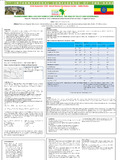| dc.description.abstract | Agriculture is a key driver for pro-poor economic growth in Kenya and supports over 80% of rural households (Amwata et al., 2015). Challenges in the agriculture sector (RoK, 2010; 2012; Nyariki et al., 2005): Limited national budgetary allocation: less than 1% of national budget, High vulnerability to climate change and variability, Use of traditional/outdated methods of production, Government preference for industrial sector with consistently high returns; thus jeopardising Kenya’s long term goal of food self-sufficiency. GoK declares a state of food emergency almost yearly with arid and semi-arid lands (ASALs) as the worst affected: over 70% of the people live below the poverty line and depend on external food aid (Amwata et al., 2015). Governments and non-governments have devised innovative ways to enhance food production, access, availability and affordability: programmes, projects, policies, capacity strengthening and financing. Even with all these efforts, Kenya still remains food insecure. This study sought to investigate the interactions between climate factors, food security and household socio-economic parameters. | en_US |

